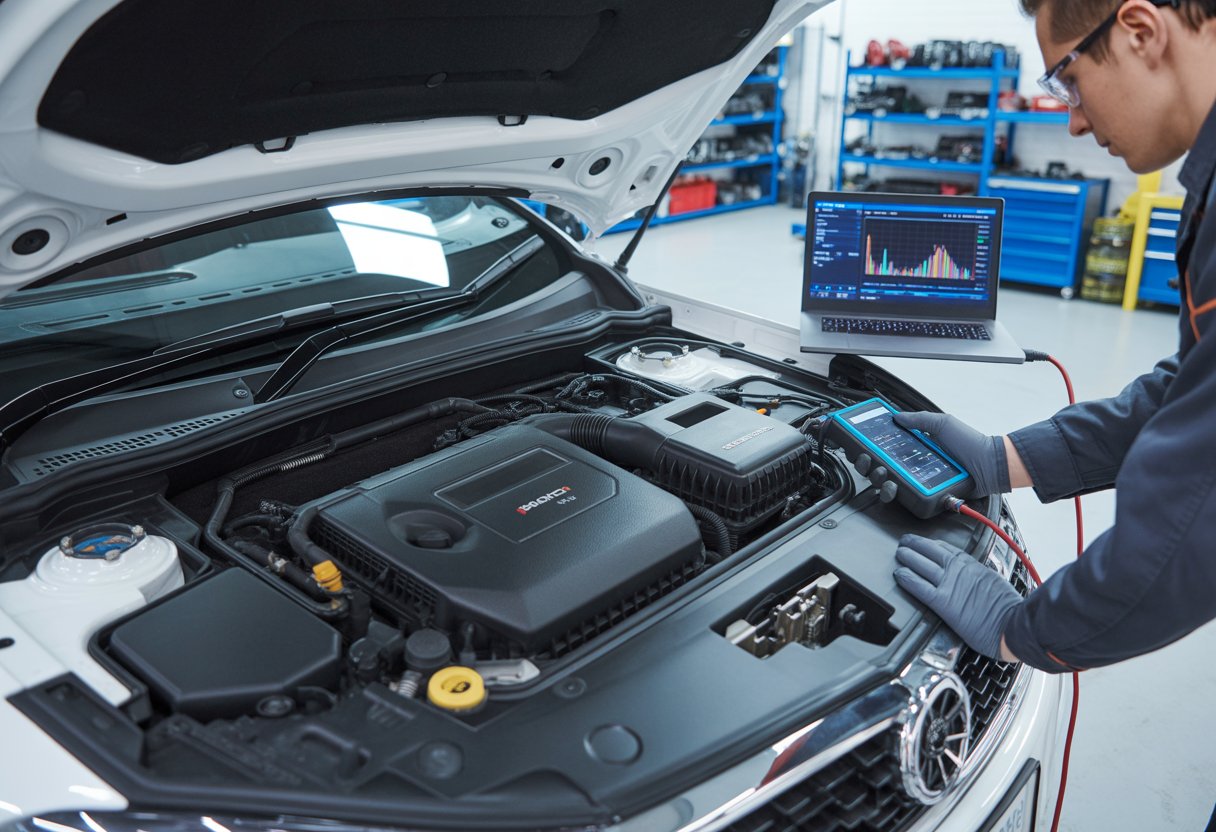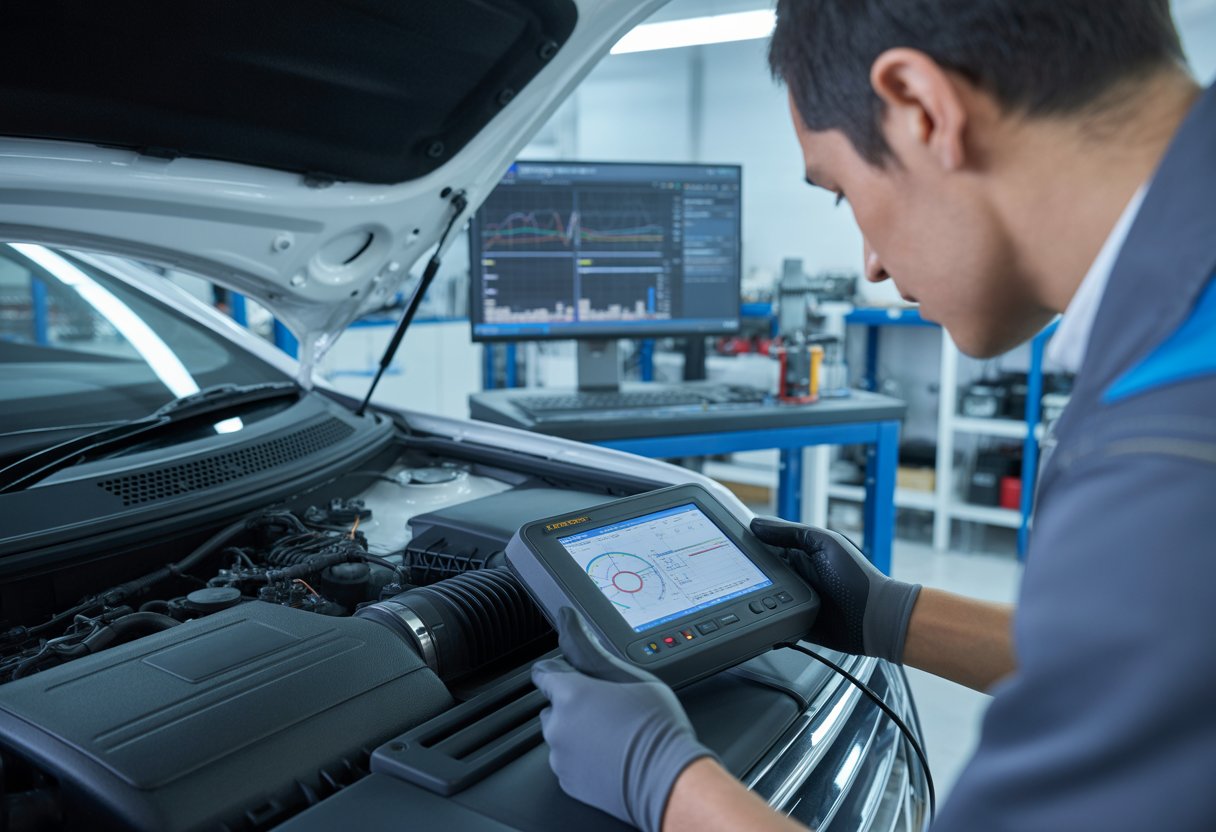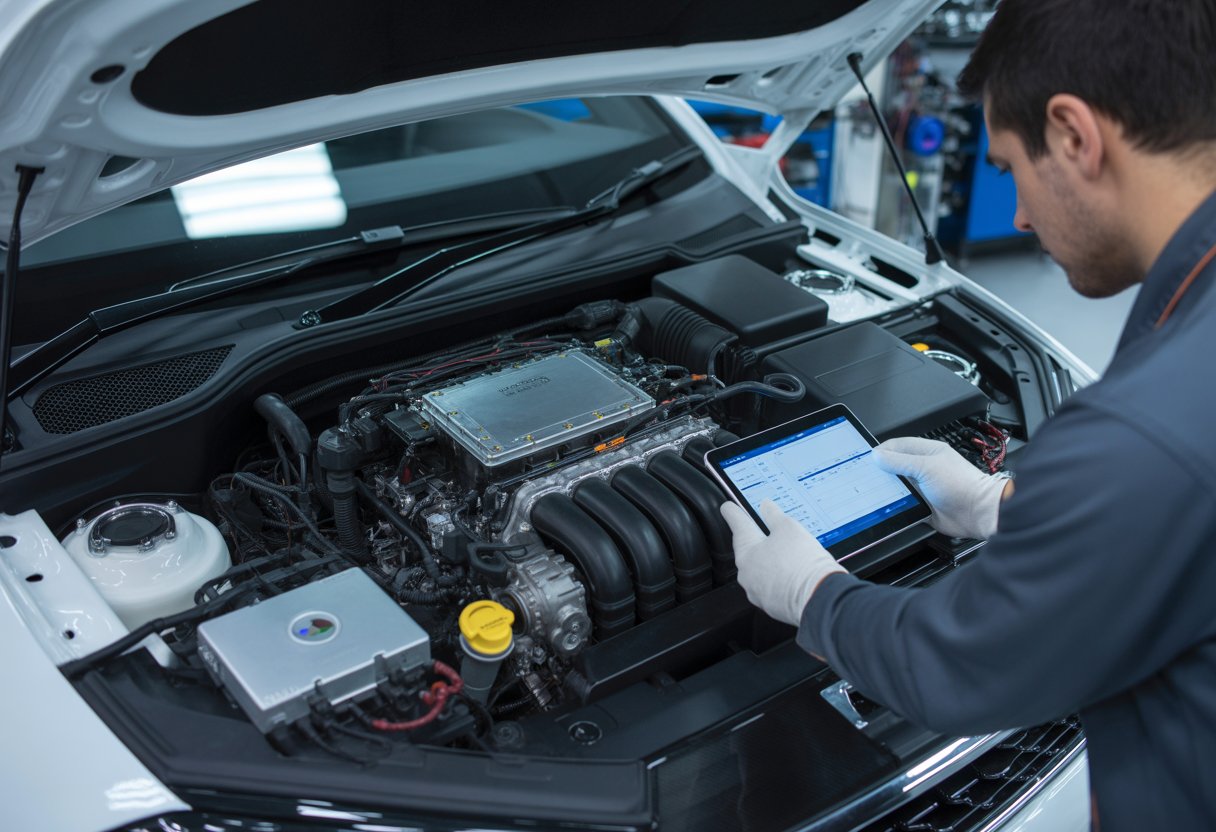Modern cars rely on complex computer systems to control engine performance, and when these systems develop problems or aren’t optimised properly, drivers may notice reduced power, poor fuel economy, or warning lights on their dashboard. Engine diagnostics help identify these issues by reading error codes and data from the car’s electronic systems, whilst ECU remapping can unlock hidden performance potential or improve efficiency.

Engine diagnostics and ECU remapping are two powerful tools that can transform how your vehicle performs, whether you’re looking to fix problems, boost power, or save fuel. Many drivers don’t realise that their car’s engine management system limits performance from the factory to meet various regulations and ensure reliability across different conditions.
Understanding these technologies empowers car owners to make informed decisions about their vehicle’s maintenance and performance. From basic diagnostic checks that reveal hidden faults to advanced remapping techniques that can increase power output by 20-30%, these processes offer practical solutions for both everyday drivers and performance enthusiasts who want to get the most from their vehicles.
Understanding Car Engine Diagnostics

Modern car diagnostics use computer systems to monitor engine performance and identify problems through fault codes. Warning lights on the dashboard signal when issues occur, whilst diagnostic tools help mechanics read specific trouble codes to pinpoint exact problems.
How Engine Diagnostics Work
Car diagnostics rely on the On-Board Diagnostics (OBD) system. This computer system constantly monitors the engine’s performance and other critical systems.
The OBD system connects to sensors throughout the vehicle. These sensors measure things like oxygen levels, engine temperature, and fuel pressure.
When a sensor detects a problem, it sends a signal to the Engine Control Unit (ECU). The ECU is the car’s main computer that controls engine functions.
The ECU then creates a Diagnostic Trouble Code (DTC). This code gets stored in the car’s memory and may trigger a warning light on the dashboard.
Mechanics use diagnostic tools to read these codes. They connect a scanner or laptop to the car’s OBD port, usually found under the dashboard.
The diagnostic tool displays the fault codes and their meanings. This helps mechanics identify the exact problem without guessing.
Common Signs of Engine Issues
Several warning signs indicate when a car needs diagnostic testing. The most obvious sign is when warning lights appear on the dashboard.
The check engine light is the most common warning. It can indicate minor issues like a loose petrol cap or serious problems like engine damage.
Other dashboard lights include the oil pressure warning, temperature gauge, and battery light. Each light points to specific system problems.
Performance issues also suggest diagnostic needs:
- Engine misfiring or running roughly
- Poor acceleration or reduced power
- Unusual engine noises or vibrations
- Increased fuel consumption
Starting problems such as difficulty turning over the engine or intermittent starting failures often require diagnostics.
Strange smells like burning oil, coolant, or fuel can indicate engine problems that need professional diagnosis.
Diagnostic Trouble Codes (DTCs)
DTCs are specific codes that identify exact problems in the engine or related systems. Each code consists of five characters that provide detailed information.
The first character is always a letter:
- P = Powertrain (engine and transmission)
- B = Body systems
- C = Chassis systems
- U = Network communication
The second digit shows if the code is standard or manufacturer-specific. A “0” means it’s a universal code, whilst “1” indicates a manufacturer-specific code.
The remaining three digits identify the specific problem. For example, P0301 means a misfire in cylinder 1.
Common DTC examples:
- P0300: Random engine misfires
- P0171: Engine running too lean
- P0420: Catalytic converter efficiency problems
Professional diagnostic equipment provides detailed descriptions of each code. This helps mechanics understand exactly what needs repair and reduces diagnostic time significantly.
What Is ECU Remapping?

ECU remapping involves modifying the software inside a car’s Engine Control Unit to alter how the engine performs. The process typically connects through the vehicle’s diagnostic port to upload new programming that changes fuel delivery, ignition timing, and boost pressure settings.
How ECU Remapping Works
The ECU remapping process starts when a technician connects a laptop to the car’s On-Board Diagnostics port. This port provides direct access to the Engine Control Unit’s software.
The original software gets read and backed up first. This backup allows the owner to return the car to factory settings later if needed.
New software then gets written onto the ECU. This software contains different instructions for managing engine functions like fuel injection timing and turbo boost levels.
The remapping process involves these key steps:
- Reading the current ECU software
- Creating a backup copy
- Installing modified software
- Testing the new settings
The new software optimises engine behaviour beyond factory limitations. Car manufacturers typically program ECUs conservatively to ensure reliability across different conditions and fuel qualities.
Types of ECU Remapping
ECU remapping comes in several stages that determine the level of modification and performance gains.
Stage 1 remaps focus on software changes only. These modifications typically increase power by 10-30% without requiring physical engine upgrades. Stage 1 remaps cost between £200-500.
Stage 2 remaps need supporting modifications like upgraded air filters or exhaust systems. These changes allow for bigger performance gains but require additional hardware investments.
Stage 3 remaps involve major engine modifications including new turbochargers, intercoolers, and internal engine components. These comprehensive upgrades can cost several thousand pounds.
Economy remaps prioritise fuel efficiency over power gains. These modifications adjust fuel delivery and timing to reduce consumption rather than increase performance.
ECU Remapping versus ECU Tuning
ECU remapping and ECU tuning refer to the same basic process but differ in scope and approach.
ECU remapping specifically describes uploading pre-written software maps to the Engine Control Unit. These maps get developed for specific engine types and performance goals.
ECU tuning encompasses a broader range of modifications including custom software development and real-time adjustments. Tuning often involves dyno testing and personalised calibration for individual vehicles.
Both processes modify ECU software to change engine behaviour. However, tuning typically offers more precise customisation whilst remapping provides proven software solutions for common applications.
Professional tuning services often combine both approaches. They start with established remap files then fine-tune the software based on specific vehicle requirements and owner preferences.
Benefits and Risks of ECU Remapping
ECU remapping offers significant performance improvements and fuel economy benefits, but comes with important warranty implications and potential reliability concerns. Vehicle owners must weigh these advantages against possible legal issues and long-term engine effects.
Performance Gains
ECU remapping delivers substantial power increases across different engine types. Turbocharged petrol and diesel engines typically see 25-30% increases in both horsepower and torque output.
Diesel engines respond particularly well to remapping due to their higher baseline torque figures. The modifications adjust fuel injection timing, boost pressure, and air-fuel ratios to unlock additional performance.
Key performance benefits include:
- Increased acceleration and overtaking capability
- Enhanced pulling power for towing applications
- Improved throttle response and engine responsiveness
- Better power delivery throughout the rev range
Turbocharged engines see the most dramatic improvements compared to naturally aspirated units. The ECU modifications optimise boost pressure and fuel delivery to extract maximum performance from existing hardware.
Professional remapping can also reduce turbo lag in forced induction engines. This creates a more linear power delivery that feels more responsive during daily driving.
Impact on Fuel Economy and Efficiency
ECU remapping can improve fuel efficiency when performed correctly, though results vary significantly based on driving habits and remap quality. Many drivers experience 10-15% improvements in fuel economy under normal driving conditions.
The efficiency gains come from optimised fuel injection timing and improved combustion characteristics. Modern remaps adjust multiple engine parameters to achieve better fuel atomisation and more complete burning.
Factors affecting fuel economy improvements:
- Driving style and habits
- Quality of the remap software
- Engine condition and maintenance
- Type of driving (motorway vs city)
However, aggressive driving with the additional power often negates fuel economy benefits. Drivers who use the extra performance frequently may see decreased fuel efficiency compared to standard settings.
Diesel vehicles typically show greater fuel economy improvements than petrol engines. The remapping process can remove restrictive factory settings designed to meet emissions standards whilst maintaining reasonable efficiency.
Warranty and Legal Considerations
ECU remapping voids most manufacturer warranties immediately upon installation. Dealers can detect remapped ECUs through diagnostic scans, making warranty claims for engine-related issues nearly impossible.
Some insurance companies require notification of ECU modifications. Failure to declare remapping can void insurance coverage and create legal complications in accident situations.
Legal considerations include:
- MOT emissions testing compliance
- Insurance disclosure requirements
- Regional modification regulations
- Fleet vehicle speed limiting laws
Professional remapping should maintain emissions compliance for MOT testing, though this isn’t guaranteed. Poor quality remaps may cause vehicles to fail emissions standards, creating legal driving issues.
Company vehicle policies often prohibit ECU modifications entirely. Fleet operators may implement speed limiting through remapping to ensure employee compliance with traffic regulations.
The modification is generally legal for road use when properly executed, but track-only remaps exist that aren’t suitable for public roads.
Gearbox and Transmission Tuning
Modern automatic gearboxes use electronic control units to manage shift patterns, torque limits, and overall performance. These systems can be reprogrammed to unlock hidden potential and improve the driving experience.
What Is Gearbox Tuning?
Gearbox tuning involves reprogramming the Transmission Control Unit (TCU) software that controls automatic gearbox operations. This process adjusts various parameters within the transmission’s electronic brain.
The TCU manages crucial functions including shift timing, torque delivery limits, and clutch pressure. Manufacturers often set conservative parameters to suit general market conditions and ensure reliability across different driving styles.
Key adjustments include:
- Shift point optimisation
- Torque limit removal
- Clutch pressure modifications
- Throttle response improvements
Professional tuners modify these settings to enhance performance whilst maintaining safety margins. The process unlocks the gearbox’s full potential without compromising mechanical integrity.
Drivers typically notice sharper gear changes, improved acceleration, and better power delivery. The transmission responds more quickly to throttle inputs and holds gears longer when needed.
Types of Automatic and Manual Gearbox Tuning
Different transmission types require specific tuning approaches. Modern automatic gearboxes offer the most tuning potential through TCU remapping.
Popular automatic transmissions for tuning:
- DSG dual-clutch systems
- ZF 8-speed torque converter units
- Mercedes 7G and 9G-Tronic gearboxes
- Ford Powershift transmissions
DSG gearboxes respond particularly well to tuning. These systems can have shift speeds reduced and launch control parameters adjusted for sportier performance.
Traditional torque converter automatics benefit from revised shift maps. Tuners can delay upshifts, improve kickdown response, and optimise gear selection for different driving conditions.
Manual gearboxes cannot be directly tuned through TCU remapping. However, engine ECU modifications can improve torque delivery characteristics to enhance the manual driving experience.
Some tuners offer specialised maps for towing applications. These modifications hold lower gears longer and increase clutch pressure to handle additional loads safely.
Integration with ECU Remapping
Gearbox tuning works best when combined with engine ECU remapping. Modern vehicles often have torque limits programmed into both the engine and transmission control units.
An engine remap increases power output, but the TCU may still restrict torque delivery in certain gears. This creates a mismatch where the engine produces more power than the gearbox will transmit.
Benefits of combined ECU and TCU tuning:
- Full power delivery across all gears
- Harmonised engine and gearbox operation
- Optimal shift points for increased torque
- Improved overall performance gains
The TCU must be recalibrated to handle the engine’s increased output safely. Professional tuners adjust clutch pressures and torque limits to accommodate higher power levels.
This integrated approach prevents the gearbox from limiting engine performance. Drivers experience seamless power delivery without transmission-induced restrictions cutting in during acceleration.
Process and Best Practices for Engine Diagnostics and Remapping
Getting proper ECU remapping requires finding qualified professionals, following systematic procedures, and maintaining strict safety standards throughout the process.
Choosing the Right Service Provider
Finding the right remapping specialist makes a significant difference in results and vehicle safety. Professional companies use proper diagnostic equipment and follow established procedures.
Key qualifications to look for:
- Professional diagnostic tools and battery support units
- Experience with your specific vehicle make and model
- Transparent pricing and clear explanations of the process
- Positive customer reviews and references
Avoid providers who skip essential steps or use inappropriate equipment like jump leads from other vehicles. Many mobile remappers cut corners to save time, which increases risks to your ECU.
Questions to ask potential providers:
- Do they perform pre-tuning health checks?
- What diagnostic equipment do they use?
- Can they provide before and after performance data?
- Do they offer guarantees on their work?
Professional services typically cost more but provide better results and peace of mind. They should explain the process in simple terms and answer all your questions.
Step-by-Step Remapping Procedure
The ECU remapping process follows specific steps to ensure safety and optimal results. Professional services complete comprehensive checks before making any changes.
1. Pre-tuning health check Technicians scan for fault codes using professional diagnostic tools. They perform visual inspections and road tests to check engine condition. Any issues must be resolved before remapping begins.
2. Data logging and baseline testing Live data logging during test drives shows how the engine performs. GPS timing equipment records acceleration times for comparison. This data helps identify the engine’s current capabilities.
3. ECU identification and reading The technician identifies the ECU type and reads the current calibration. They check if previous tuning has been done. Battery support units maintain stable voltage during this process.
4. File modification and writing Experienced technicians modify the ECU software at their headquarters. The process typically takes 30 minutes for manual calibration changes. New settings are then written to the ECU.
Safety and Quality Assurance
Safety measures protect both the vehicle and ECU during remapping. Professional services follow strict protocols to prevent damage.
Critical safety equipment:
- Battery support units maintain stable voltage
- Professional diagnostic tools prevent communication errors
- Proper OBD connections ensure secure data transfer
Temperature and weather conditions affect the remapping process. Technicians avoid working in extreme conditions that could compromise results.
Quality checks include:
- Final diagnostic scans to clear fault codes
- Post-remap data logging to verify changes
- Road testing to confirm improved performance
- Follow-up contact within 24 hours
Mistakes during remapping can cause engine damage or complete failure. Professional services document everything and provide copies of diagnostic reports. They also perform basic safety checks on tyres, oil levels, and other components.
Reputable companies offer guarantees on their work and support customers after completion. They use dyno-proven calibrations rather than generic files that may not suit your specific vehicle.
